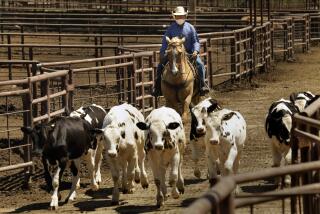Beef Goes on a Diet That Gives Leaner Steaks
- Share via
WASHINGTON — Cattle producers are already turning out much leaner beef than many people think, and those steaks, roasts and burgers probably will lose still more flab if consumer demand continues, says a new study by Texas A&M.;
Moreover, although researchers say it is hard to tell for sure, those juicy fast-food hamburgers probably are leaner than they sometimes look.
Overall, the Texas A&M; study found the amount of visible or separable fat was down 27% in retail cuts from two years ago, and the fat content of ground beef was down 10%.
The study, which was released Wednesday by the Agriculture Department, involved supermarket surveys in late 1987 and early 1988 in Atlanta, Chicago, Dallas, Denver, Detroit, Houston, Los Angeles, New York City, Philadelphia, Seattle, Tampa, Fla., and Washington.
Randomly selected retail beef cuts contained an average of 78.9% separable lean, 11.7% separable fat (3.3% external fat and 8.4% “seam” or intermuscular fat), and 9.4% separable bone and connective tissue.
The weighted average of fat content of all retail beef cuts in the 1988 survey was 9.99%, compared to 13.76% fat in 1986.
H. Russell Cross of Texas A&M; told a news conference that while Americans like beef, their perception is that it is a fatty product.
Earlier studies showed “marked improvement” in consumer perception when the outside fat on retail cuts was trimmed to one-quarter inch of fat or less, compared to the previous standard of one-half inch. Most retailers began using the quarter-inch fat trim after 1985.
“The reduction in separable fat meant that longstanding assumptions on amounts of fat that Americans were getting from beef perhaps were not correct” and that more up-to-date information was needed, Cross said.
As a result, the USDA’s Agricultural Research Service put up $20,000; the Cattlemen’s Beef Promotion and Research Board, $20,000; and the Beef Industry Council, $5,000 for the new study. The project was administered by a foundation of the National Cattlemen’s Assn.
Jeff Savell, a Texas A&M; colleague, said the study found that more than 40% of the retail cuts had no external fat.
The average fat thickness on steaks and roasts from primal cuts, or the major wholesale cuts, was 0.14 inch, while the average for all cuts, from chuck roast to stew meat was 0.11 inch, or less than one-eight of an inch, he said.
“We found that the amount of beef fat in American supermarket meat cases on a given day is now 1.2 million pounds less than in former years,” Savell said. “That’s 4 1/2 billion fewer calories.”
A committee of the National Research Council recently reported that Americans are eating too much fat and urged the industry and government to help correct the situation by breeding leaner animals and changing federal grading regulations.
Cross said the latest survey showed that in the case of beef the less-fat recommendation of the scientific panel is being carried out.
“The next step in the war on fat is to trim more of the fat at the packer level, where it can be done more efficiently,” he said. “Eventually, we must depend less on butchers’ knives to get rid of the fat and more on production of leaner cattle.”
Further changes are needed in the marketing system so that cattle producers are rewarded financially for turning out cattle with less trimmable fat, he said.
Cross said the impact of leaner beef on fast-food hamburgers is difficult to determine.
“First, we need to realize that the fast-food ground beef is probably not as fat as you might expect,” he said. “The average fat content is probably somewhere between 18% and 20% for the fast-food hamburger, whereas the average for this study was right around 19%.”
That doesn’t mean your favorite juicy burger at the local drive-in is leaner than the meat bought at supermarkets.
“There’s essentially three kinds of hamburger that are normally offered at retail--regular, which is around 23 or 24% fat; lean, which is around 18 or 19; and extra-lean, in this study, which was around 14 to 15,” Cross said. “So, fast-food ground beef is right in the middle of the pack.”
More to Read
Eat your way across L.A.
Get our weekly Tasting Notes newsletter for reviews, news and more.
You may occasionally receive promotional content from the Los Angeles Times.








